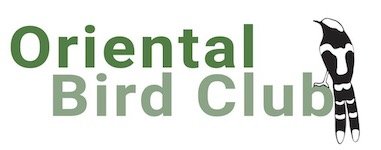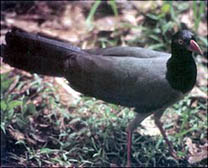Birdwatching areas: Bach Ma National Park, Vietnam
by Richard Craik, from OBC Bulletin 33, June 2001.
Introduction
Bach Ma National Park (BMNP) is situated in the narrow central region of Vietnam, just north of the Hai Van Pass where the Annamite Mountain Range meets the South China Sea. This location, sandwiched between the coast and the mountains gives Bach Ma and the immediate surrounding area a microclimate and the weather tends to be rather changeable, unpredictable and very wet. Indeed, Bach Ma has some of the wettest weather in Vietnam with around 8,000 mm of precipitation falling annually at the summit. Fortunately, most of this falls in just three months of the year, between September and November.
Following the discovery of Bach Ma in 1932 a road was built to the summit and the area just below was developed into a hill station. By the end of the 1930s there were 139 villas, a hotel and a general store and the area was a popular weekend getaway for members of the French colonial administration. During the thirties the first forest trails were opened and in 1934 a section of Bach Ma was classified as a forest reserve. Being an area of strategic importance, Bach Ma was the scene of heavy fighting in the early fifties and again through the sixties and seventies, during which time large tracts of forest were destroyed by chemical defoliants. In 1986 the government of the Socialist Republic of Vietnam embarked on a conservation programme creating 87 protected areas including Bach Ma. In 1991 Bach Ma was officially classified as a national park with 22,031 ha at its core and a buffer zone of 21,300 ha (1).
Bar-bellied Pitta © Jonathan Eames
Forming a green corridor from the Annamite Mountains to Vietnam's coastal plain, Bach Ma National Park is the only surviving area of forest extending from the South China Sea to the Laos border. The geology of the park is dominated by granite with areas of overlying sandstone. As is often the case in wet tropical regions the soil is generally rather poor but nevertheless supports a lush and diverse vegetation. The topography is steep and rugged with several peaks over 1,000 m, including Mount Bach Ma itself, the highest at 1,448 m. The lower slopes are much gentler and are characterised by numerous natural mountain springs which drain into rivers and lagoons along the alluvial coastal plain.
The tropical monsoon climate of this region of central Vietnam (usually referred to as Central Annam in field guides) is typified by two major weather patterns: a hot dry season caused by warm winds sweeping in from Laos between May to July and a monsoon season bringing heavy downpours and frequent typhoons on north-east winds from September until November.
Lowland evergreen forest is the dominant forest type below 900 m with montane evergreen forest taking over above this elevation. Due to human interference no undisturbed forest remains and scrub and grassland species such as Rhodomyrtus tomentosa, Melastoma candidum and Imperata cylindrica are the dominant forms of vegetation. While these areas of scrub and grassland are of little conservation value, the remaining forested areas are still rich in plant diversity.
The mammal fauna of the park has yet to be comprehensively surveyed and so far only 48 species of mammal have been confirmed to occur. Included in this figure however are some mammal species of particular conservation concern such as Red-shanked Douc Langur Pygathrix nemaeus nemaeus and Buff-cheeked or White-cheeked Gibbon Hylobates gabriellae/leucogenys.
Main characteristics of the avifauna of Bach Ma NP Lying at the southern extent of the Annamese Lowlands Endemic Bird Area, Bach Ma is known to support at least four of the restricted-range species found in this EBA: Annam Partridge Arborophila merlini, Crested Argus Rheinardia ocellata, Short-tailed Scimitar Babbler Jabouilleia danjoui and Grey-faced Tit Babbler Macronous kelleyi (1). The most characteristic feature of Bach Ma's avifauna is the large number of Galliformes living within its boundaries. Of the twelve species of pheasant recorded in Vietnam, seven occur, or have at one time occurred, in the park. An endemic subspecies of Silver Pheasant Lophura nycthemera beli (2) is found within the park and Edwards's Pheasant L. edwardsi, believed extinct until it was rediscovered in 1996 at Dakrong, was recorded just outside the park buffer zone in 1998 (3). Other specialities include Red-collared Woodpecker Picus rabieri, Red-vented Barbet Megalaima lagrandieri, Blyth's Kingfisher Alcedo hercules, Coral-billed Ground Cuckoo Carpococcyx renauldi, Blue-rumped Pitta Pitta soror, Bar-bellied Pitta Pitta elliotii, White-winged Magpie Urocissa whiteheadi and Ratchet-tailed Treepie Temnurus temnurus. A bird list of BMNP, available at the park headquarters, was compiled in 1996 by Roland Eve and contains 330 species (1).
Conservation issues affecting Bach Ma Following the reunification of Vietnam in 1975, logging by state forest enterprises saw the removal of most of the commercially valuable timber in the park during the ensuing ten years. Illegal harvesting of forest products has continued and regular fires inhibit the regeneration of logged areas. Although the park is home to only 65 households (4) the park buffer zone supports a population of over 61,000 people (2). Collection of forest products, exhausted near to the villages, is a major source of income for families living in the buffer zone and exploitation of these products is occurring at unsustainable levels.
In order to extend the conservation coverage of the national park, BirdLife International together with the Forest Inventory and Planning Institute (FIPI) proposed a 22,500 ha extension to the east. The exact boundaries of the extension have yet to be defined but it is likely to include all or part of the Hai Vai Pass area with its cultural and historical sites.
Birding in Bach Ma national park April through to July are the best times to visit, before the rains kick in at the beginning of September. From September onwards conditions can be very unpleasant with cool temperatures, high winds, heavy rain and very muddy conditions underfoot. During this time, leeches are out in force along the forest trails. The early spring from January to March is cool with continuous drizzle and sometimes heavy rain.
Coral-billed Ground-Cuckoo © Jonathan Eames
The best birding is along the surfaced road winding up to the summit from the park guesthouse and on the various trails which are sign-posted off this road. Several of the trails lead to waterfalls and streams and with luck Blyth's Kingfisher and Red-headed Trogon Harpactes erythrocephalus can be found. Along the roadsides in the vicinity of the guesthouse is a good place to look out for Silver Pheasant in the early morning or late afternoon. Foraging parties of Striated Yuhina Yuhina castaniceps are a common sight among the roadside trees and bushes and Golden Babbler Stachyris chrysaea, Mountain Fulvetta Alcippe peracensis, White-bellied Yuhina Yuhina zantholeuca, White-browed Shrike Babbler Pteruthius flaviscapis, Red-whiskered Bulbul Pycnonotus jocosus, Puff-throated Bulbul Alophoixus pallidus and White-throated Fantail Rhipidura albicollis can usually be easily observed from the road. It is worth checking out the small streams that trickle out from either side of the road at various points for Slaty-backed Forktail Enicurus schistaceus as well as Streaked Wren Babbler Napothera brevicaudata skulking among the roadside rocks. Looking skywards as you follow the road to the summit a Black Eagle Ictinaetus malayensis may be seen circling over the treetops. Rachet-tailed Treepie, with its distinctive barbed tail, is fairly common at Bach Ma and can sometimes be encountered along the unmarked forest trails that lead into the forest near the large concrete sign about a kilometre below the summit. This can also be a good area to look for Lesser Necklaced Laughingthrush Garrulax monileger and White-gorgetted Flycatcher Ficedula monileger among others.
Before leaving Bach Ma look out for the Tri Sao Trail, or Pheasant Trail, sign-posted halfway down the road between the guesthouse and park headquarters. This well maintained trail is a good place to look for the Crested Argus, or Tri Sao as it is known locally, although it is more often heard than seen. If you have no luck on the Tri Sao Trail you can always check out the captive Crested Argus kept in an aviary near to the headquarters building.
Access and facilities
To get to BMNP it is either a 45 km drive south from Hue or a 65 km drive north over the Hai Van Pass from Danang. It is in theory possible to get a local bus from Hue or Danang and to be dropped off at the town of Cau Hai on Highway 1 at the turn off to Bach Ma. From here take a motorbike taxi to the park headquarters another 3 km up the road. However, without a knowledge of Vietnamese and a good idea of where you are going, this is not recommended. If you want to be sure of arriving at the right place it is better to either hire a car with driver or motorbike taxi from Hue or Danang to take you to the park. Once at the headquarters transport can be arranged to take you to the guesthouse. Motorbikes, other than those of the park rangers, are not allowed inside the park.
The guesthouse facilities are 17 km from the park entrance and headquarters and 3 km from the summit. The two main buildings are the renovated former police station and colonial police chief's villa on the opposite side of the road. Various-sized rooms are available here, some with en suite facilities, others with rather basic outdoor washrooms. There is a large canteen, where simple Vietnamese food, beer, mineral water and soft drinks can be ordered. Electricity is provided by a generator from 6 pm to 10 pm. At the time of writing (March 2001) the facilities are undergoing major renovation and ten of the ruined colonial villas are to be restored this year. There are also plans to completely renovate the former Morin Hotel just below the summit. Whether this will be good or bad news for visiting birders remains to be seen!
Accommodation should always be booked in advance if possible, especially at weekends during the summer months. For reservations call +84 54 871330/871328/871528 or fax +84 54 871328. Park guides can be hired if booked in advance with the headquarters. Ask for Minh, who speaks good English and can point you in the right direction to look for some of the local goodies.
Acknowledgements
Many thanks to BirdLife International Vietnam Programme for their assistance in preparing this article.
References
Eve, R. (1996) Birdlist of Bach Ma National Park. Hue: WWF/EC Bach Ma National Park Project.
WWF/EC (1997) Proposed second revision of the Bach Ma National Park management plan. Hue: WWF/EC Bach Ma National Park Project.
Huynh Van Keo (2000) White-crest Grey Pheasant is found at Bach Ma National Park. Lam Nghiep (Vietnam Forest Review) January/February 2000: 39-40. (In Vietnamese).
Gilmour, D.A. and Nguyen Van San (1999) Buffer zone management in Vietnam. Hanoi: IUCN Vietnam.
See Sales for prices and availability of Bulletin past issues Return to Bulletin index


